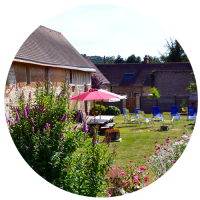Virtual tour
Let yourself be charmed by the cottage’s cosy and beautiful setting, its charming bricks, and the silence of the countryside. You will feel at home, away from home, in a calm place that is both modern and rural.

Our services
Situated in a picturesque village in the Eure Valley, our cottage is dedicated to groups and can host up to 20 people in the sleeping accomodations, and 35 people in the reception area. A variety of equipment is available for your comfort.
A little history
Our eco-friendly holiday cottage was previously a farm. You would have found:
• A cowshed with milk cows, with an attic where hay was stored – A barn to store oats – A half storey to store wheat, underneath which were two cellars where potatoes were stored – A hay barn – A cart shed with an attic to store barley (this part has been completely removed).
The street parallel to the cottage was previously called “le chemin des granges” (barn road), where you would have seen several barns that were used to put the harvest into storage. The barns were built in the 19th century by the present owners’ ancestors, six generations back.
Traditional materials
During the renovation of our two agricultural buildings from the beginning of the 19th century, the original materials have been preserved as much as possible.
• Wood (oak, beech, douglas fir),
• Stone (rubble, sandstone, flitstone),
• Bricks and mudbrick, using cob constructions techniques.
• “Modern” construction materials were used sparingly, and only when the use of traditional materials was impossible or when it exceeded the craftsmen’s expertise.
• Below, you will find a slide show of the buildings as they were before the renovation, which will allow you to see the extent of the work carried out for our “Champ de l’être” cottage to become what it is today.
An eco-friendly approach
We have installed as many eco-friendly systems as possible:
• Hot sanitary water is produced with solar panels.
• The cottage is heated by a wood-pellet-fuelled boiler.
• The exterior walls are isolated with cellulose wadding.
• Rain water is recuperated for non-drinking purposes.
• Dual flow ventilation with a static heat exchanger.
• Canadian or Provencal well to precondition new air.
• Independent phyto-purification system.




